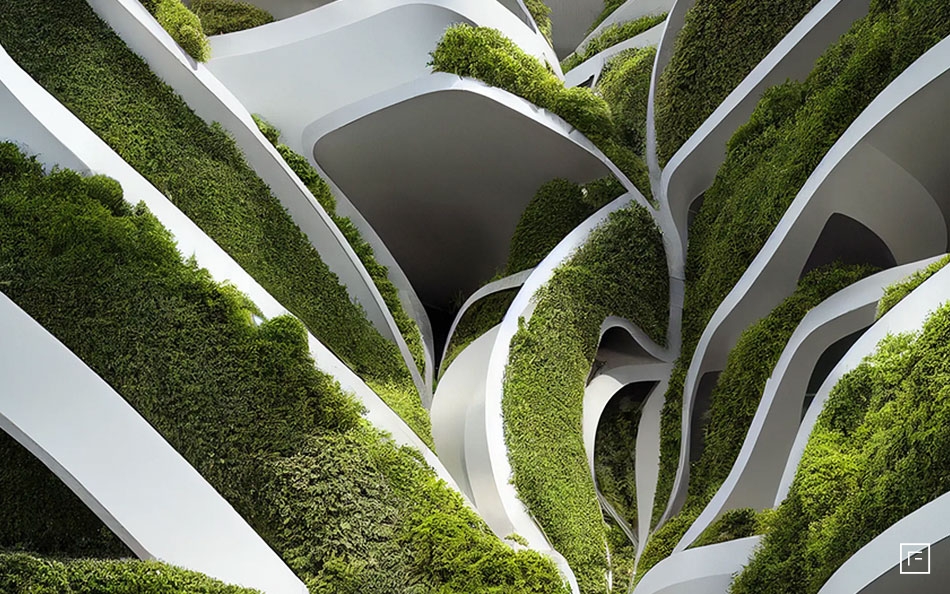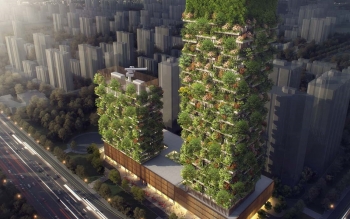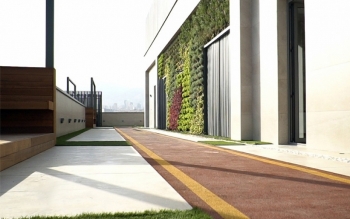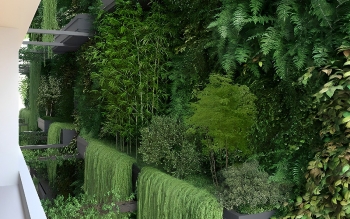Green Architecture:
Green architecture is a set of approaches, technologies, materials, and designs that are implemented to reduce the negative effects of buildings and cities on the environment and also improve the living quality of their residents. In green architecture, buildings and urban structures are designed to preserve and improve the environment, using renewable and sustainable energies. The aim of green architecture is to reduce energy consumption, improve air quality, decrease the amount of waste production, use natural resources, and preserve the environment.
Some principles of green architecture include utilizing natural light and lighting, reducing energy consumption, using smart systems as well as green and sustainable materials, a green and low-impact design, reducing air and water pollution, and also using green space in the design of urban structures.
Green architecture is currently used in many cities due to its positive impacts on the environment and the quality of life of the residents.
What is the reason for proposing green architecture for urban development?
There are several reasons to propose Green architecture as a proper suggestion for urban planning. One of the main reasons is that due to increase in population and traffic, industrialization, and use of natural resources, cities have faced a lot of issues and problems, including air pollution, worsening of climate change, water quality degradation, and human health risks. In such situation, by creating green spaces and employing sustainable technologies, green architecture can help improve the quality of life of citizens and reduce the negative effects of the cities on the environment.
In addition, by creating green spaces, green architecture assists the production of oxygen and absorbing air pollutants. Through growing vegetables across the city, dependence on the export of agricultural products is also reduced. Moreover, the further the quality of green spaces in the city improves, the higher becomes the level of welfare and outdoor recreational activities could be more available which leads to an improvement in the health level of the society.
Furthermore, green architecture can play a role in enhancing the economic conditions of cities as it reduces energy consumption in buildings. Such reduction in energy consumption has decreased costs related to energy supply and supported sustainable and environmental industries. Providing energy from sustainable sources, makes it possible to help increase the cities security in terms of energy.
In general, green architecture is considered as a notable solution in construction and it diminishes the destructive impacts of buildings on the environment. It tries to reduce emission of greenhouse gasses through optimal use of natural resources, energy consumption, and improvement in air and water quality, etc. in order to preserve the environment along with elevating the level of welfare and quality of life of the people.
Optimizing the use of light and natural lighting in green architecture:
In this method, in the design and construction of buildings and green spaces, it is tried to fully use the sunlight and natural lighting in order to decrease consumption of energy for lighting and similar matters; thus stepping on the path of sustainability and preserving the environmental.
In designing buildings, architects try to provide a more and better supply of sunlight for interior spaces through methods such as proper arrangement of windows and glasses.
In this style, windows and glasses are designed in such a way that during the day, the best sunlight and natural lighting are provided in the interior spaces of the building based on the direction and general location and situation of the structure.
Also, in designing the green spaces, optimizing the use of light and natural lighting would decrease energy consumption for lighting green spaces. Creating shades by trees, for instance, we can make the best use of sunlight in the green areas and at the same time, bring down the consumption of energy for lighting these spaces.
Generally, optimizing the use of light and natural lighting in green architecture could be a great help if and when reduces the expenses and energy consumption, increase comfort and health in indoor spaces, and expand and further our connection with the environment and nature in buildings and green spaces.
If use of light and natural lighting is optimized, then it would be possible to design in such a way that during the day, our buildings and green spaces have the required light and lighting with only the energy of the sun. This way, in addition to reducing energy consumption and costs, great comfort and health could be provided for the residents and users of green spaces and buildings.
Besides, this method can lead to an improvement in our connection with the environment and nature. With the optimal use of sunlight and natural lighting, green spaces and buildings become closer to and interact more with the environment and nature, giving users and residents the opportunity to further enjoy the beauty and advantages of the nature.
In short, optimizing the use of light and natural lighting in green architecture can improve the quality of life in green spaces and buildings and help protect and preserve the environment.
Reducing energy consumption in buildings:
Reducing energy consumption in buildings is one of the main aims of green architecture.
Through using various methods such as bettering air conditioning systems, using clean and renewable energy sources, optimal use of light and natural lighting, appropriate design of green spaces, and using high-quality and low-consumption materials and equipment, energy consumption in buildings could be minimized.
In general, reduction of energy consumption in buildings means improving the quality of people's life in buildings and areas with green spaces, preserving the environment, and reducing energy expenses and economic costs.
Using natural and effective air conditioning systems:
Using natural and effective air conditioning systems in green architecture means employing natural resources to ventilate the building. These systems usually include the use of wind, light, and natural heat and cold, the combination of which can keep the building at the right temperature.
In order to use natural air conditioning systems, on of the solutions used in green architecture is the use of green coverage [in the buildings], creating cool buildings through proper design plans, use of ceiling vents and windows, and clean energy equipment such as solar panels.
To employ natural and effective air conditioning systems in green architecture means improving the quality of people's life in buildings and areas with green spaces, preserving the environment, and reducing energy expenses and economic costs. By using such systems, maintaining proper temperature, humidity and air quality in green spaces and buildings becomes possible.
Use of green and sustainable materials:
Using green and sustainable materials in green architecture means using materials that result in decrease in negative effects on the environment. These materials can be produced from sources such as recycled, natural, and sustainable materials, which have less environmental [negative] impact than conventional materials.
For example, in construction, materials such as recycled concrete, marble texture wood, quality FSC (Forest and Farmland Stewardship Control), and natural stones could be used.
Moreover, the use of green coverings such as green roofs and walls could not only reduce the negative effects on the environment, but also improve air quality and urban density.
Using green and sustainable materials, the environment would be helped through design and construction of buildings and green spaces and bring down the amount of energy consumed and construction costs. The use of green and sustainable materials can also play an important role in maximizing the quality of life and health of residents and users of green spaces and buildings.
Design of buildings with high energy efficiency:
Designing buildings with high energy efficiency in green architecture means to design and construct buildings in which advanced technologies and intelligent design have been used in order to minimize energy consumption. In this type of design, various methods are employed to reduce energy consumption, including:
- Using renewable energy sources such as the sun, wind, heat, and running water to supply energy for buildings and related equipment.
- Proper design of air conditioning systems, lighting, wall and floor coverings that can help decrease consumption of energy and construction costs.
- Use of building materials with proper thermal insulation, low consumption and sustainability for construction operations.
- Reducing greenhouse gasses emissions and other environmental impacts related to energy consumption, including carbon dioxide production and construction waste production.
This type of building design can help reduction of energy consumption and construction costs, improving the quality of residents' lives, as well as decrease in negative impacts on the environment. Furthermore, designing buildings with high energy efficiency in green architecture can contribute to sustainable development and creating green cities.
Designing buildings with high energy efficiency in green architecture can also play an important role in development of green economy. When the energy consumption is reduced, renewable energy resources are used, then less air and water pollutants are produced, energy costs are decreased, job opportunities in the field of sustainable energy are created, and the environment is also protected and preserved.
Design of buildings with high energy efficiency in green architecture brings about the following benefits to cities and communities:
- Reducing energy and construction costs: Using energy production systems of its own, reducing energy consumption and employing high-performance materials, this design method minimizes construction and energy costs.
- Improving the quality of life: Buildings with high energy efficiency can improve the quality of life and create healthy and proper living conditions for the residents of cities and communities.
- Reducing negative impacts on the environment: Using renewable resources of energy and reducing energy consumption can help decrease negative impacts on the environment and preserve it instead.
- Sustainable development and creation of green cities: Designing buildings with high energy efficiency in green architecture can contribute to sustainable development and creation of green cities.
- Use of solar systems: One of the ways to optimize energy consumption in green buildings is to use solar systems. These systems can supply the electrical energy required for lighting, heating and cooling of buildings.
- Optimization of internal spaces: In the design of green buildings, attention should also be paid to the optimization of the internal spaces of buildings. For example, light, low-consumption and high-quality furniture are usually used in these design style, and interior space optimization methods are used to reduce energy consumption, including proper lighting, temperature and humidity control, etc.
- Smart design: Designing smart buildings is one of the characteristics of green architecture. In such buildings, there are intelligent systems to control temperature, lighting and other things related to the building which improve energy efficiency and reduces consumption.
- Use of modern construction systems: In the design of green buildings, modern construction systems such as prefabricated construction systems are employed. These systems improve the quality of construction, increase the pace of construction operation and decrease the consumption of energy and materials used in the building.
- Using intelligent systems to control energy in buildings: This means the use of advanced technologies to reduce energy consumption and increase efficiency in air conditioning systems, lighting and other systems related to the building. Using different sensors and smart algorithms, these systems have the ability to control energy consumption in the building more accurately and intelligently.
These systems help decreasing energy costs in the building and increase the productivity and efficiency of the building. For instance, by using smart systems, air conditioning and lighting systems can be turned off automatically when nobody is inside the building, and when people are there, the proper light and temperature could be adjusted according to their need.











